



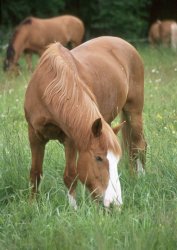 |
| A 15 year old Finnhorse gelding, bred for trotting but now used as a riding school horse. |
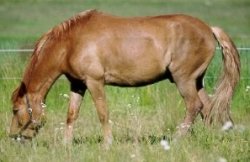 |
| Shows a very typical Finnhorse, turned out for the summer. |
The Finnhorse's head is plain but honest, with an alert, interested and
friendly look. The eyes and ears are medium-sized. The profile is straight.
The jaw may be a little heavy and the head thick-set, leading to a stocky,
strong, sometimes short neck. Some horses with heavy jowls find it
difficult to achieve true collection. Most horses, however, are physically
able to move in a correct outline.
The Finnhorse's gaits are active and energetic. The horses often find trot
their easiest gait. The walk is energetic and long. The canter is round and
does not always cover as much ground as the fast, scopey trot.
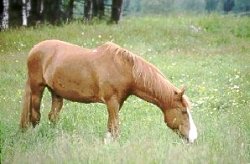 |
| The same 15 year old Finnhorse gelding |
Being partly a draught horse, the Finnhorse's shoulder is rather upright, resembling the Irish Draught Horse's shoulders. The withers and back are well-made and the limbs strong and uniform. The joints are dry and flat and hooves hard. The quarters and hind legs are powerful, giving the Finnhorse speed and strength for the faster equestrian sports. The mane and tail are long and thick, resembling fishing-line rather than silk. There is little feather on the feet - usually less than on Welsh Cobs but more than on Warmbloods.
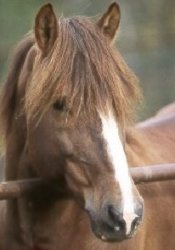 |
| A typical Finnhorse head with a rather straight profile and an alert, interested look. |
For the sake of comparison, the Finnhorse resembles none of the native
British breeds. Light cobs or heavy-built small hunters come nearest, and
the pony section Finnhorse may resemble light Highlands, heavy New Forests
or some untypical Welsh Cobs with a low head carriage. The draught type
might resemble a Suffolk Punch / Thoroughbred cross.
The typical height of a Finnhorse is 14.3 15.3 hands (153 164 cm), but
there have been individuals exceeding 17 hands (177 cm). Finnhorses under
148 cm (14.1 hands) are listed as pony-section Finnhorses (literally "small
Finnhorses"). They are allowed to compete in trotting with larger horses,
and in ridden sports they can compete and be shown in pony classes. They
are shown annually in the national pony along with British and other
European pony breeds.
 |
| Finnhorses tend to be very interested in their surroundings, yet calm and relaxed when seeing or learning new things. |
Like most native breeds, the Finnhorse is slow to mature, and a 4-year-old is still a baby. Most trotters are broken to harness at the age of one to three years, but riding horses are never mounted before they are three or four. Trotters start racing at the age of three or four, and many continue racing well into their teens.
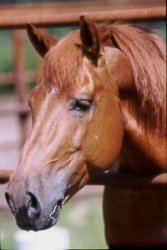 |
| Duka, a successful trotter stallion that was recently accepted in the Finnhorse stud book. |
Because of its versatile use, the Finnhorse has been bred easy to handle,
yet fast and strong. Finnhorses are honest, tough and friendly, often
eager to please their handlers. They are long-lived, hardy and "good
doers". They have enough stamina to stand the harsh Finnish winters and
compete in extreme sports such as trotting or endurance riding.
Traditionally, the same horse has been used for farm work and long trotting
contests on the way to church services or fairs.
For Finnhorse enthusiasts, the highlight of the year is the Trotter King
and Trotter Queen contest, in which the participants trot a total of three
races on two consecutive days. In ridden sports, national Finnhorse
championships are competed in dressage, showjumping and eventing.
The first official Finnish trotting races were held in 1817 on the frozen
River Aurajoki in southwestern Finland. The Trotter King and Trotter Queen
tradition was established in 1924.

Click Here
or send an email to
joynext@field-galleries.co.uk
to be notified when the next issue
of the magazine is published
If you wish to get in touch about another matter then please use the contact form